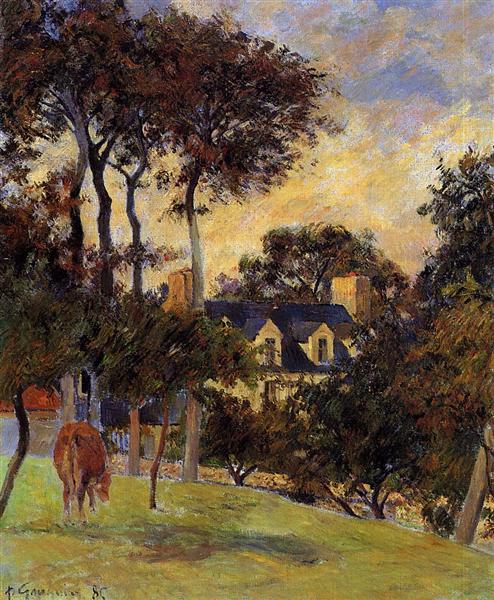Description
Paul Gauguin's painting "White House" (1885) is an intriguing work that reflects the transition of his artistic approach towards exploring more vibrant and symbolic shapes and colors, characteristics that would define him in his later career. This canvas is a representation of the house that Gauguin inhabited during his stay in Pont-Aven, a picturesque village in Brittany, France, where he experimented with post-impressionist art. The work offers a clear insight into his desire to capture the essence of the place through a bold color palette and simplified design.
The composition in this work features an imposing home, central to the scene, rising with a white facade that, as the title indicates, becomes the main subject. The house, with straight and solid lines, is surrounded by lush vegetation that seems to embrace it, suggesting a harmony between architecture and nature. This interaction becomes a crucial element in many of Gauguin's works, where human creation and the natural landscape are often intertwined.
The mostly saturated colors move the depiction away from photographic realism, moving more toward symbolism, a characteristic feature of Gauguin’s approach. The areas of color covering the house contrast with the deep green of the surrounding trees and grass, further emphasizing the architectural structure. This use of color becomes a tool not only for aesthetics, but to invoke sensations and emotions, transporting the viewer to a state of contemplation and connection with the place.
In “White House,” the absence of human figures is notable. In this sense, Gauguin departs from his later tendency to include indigenous characters living in Tahiti, a place he would explore later in his career. In this 1885 painting, the depiction of everyday life seems to be relegated to the surroundings, suggesting that the house itself is a symbol of the life that might inhabit it, a silence that invites interpretation.
Another fascinating aspect is how the work sits within the context of his development as an artist. At the time of painting "White House," Gauguin was under a variety of influences, from Impressionism to Symbolism; this painting reflects an approach that moves away from traditional portraiture and landscape, seeking instead a deeper essence of the place depicted. It is a turning point in his search for an art that, through the choice of color and form, communicates sensations beyond mere observation.
Gauguin's work, though often framed by criticism, has been fundamental in the evolution of modern art. His tendency to use colour in unconventional ways, his attraction to subjective reality and his exploration of symbolism have left an indelible mark on the history of art. "White House" is therefore not just a landscape, but a testament to his growth as an artist and his ability to capture the essence of a time and place through colour and form. In this context, the painting stands as an example of the beginning of a new way of seeing the world that will inspire generations of artists to come.
KUADROS ©, a famous painting on your wall.
Hand-made oil painting reproductions, with the quality of professional artists and the distinctive seal of KUADROS ©.
Painting reproduction service with satisfaction guarantee. If you are not completely satisfied with the replica of your painting, we will refund 100% of your money.

